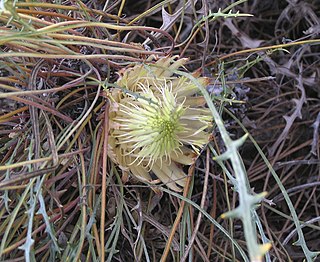
Banksia columnaris is a species of column-like shrub that is endemic to Western Australia. It has pinnatifid leaves with between five and eighteen lobes on each side, heads of pale yellow to purple flowers and usually only one or two follicles forming in each head.
Banksia densa is a species of column-like shrub that is endemic to Western Australia. It has deeply serrated to pinnatifid leaves, creamy yellow flowers in heads of up to seventy-five, and hairy follicles.
Banksia cypholoba is a species of dwarf, prostrate shrub that is endemic to Western Australia. It has pinnatipartite leaves with twenty-five to forty triangular lobes on each side, heads of about sixty brownish and yellow flowers and mostly glabrous follicles.
Banksia echinata is a species of shrub that is endemic to Western Australia. It has serrated leaves with nine to twenty-five sharply pointed, triangular teeth on each side, heads of about fifty pale yellow flowers and sparsely hairy follicles.
Banksia fasciculata is a species of column-shaped shrub that is endemic to Western Australia. It has hairy stems, crowded, prickly leaves, yellow flowers and hairy fruit.

Banksia rufa is a species of prostrate shrub that is endemic to the south-west of Western Australia. It has broadly linear, pinnatifid or pinnatipartite leaves with between five and twenty lobes on each side, yellow, orange or brownish flowers in heads of forty or more, and glabrous, egg-shaped follicles.
Banksia glaucifolia is a species of shrub that is endemic to Western Australia. It has deeply serrated, wedge-shaped leaves with sharply pointed lobes, pale yellow flowers and follicles with hairy edges.

Banksia hirta is a species of shrub that is endemic to Western Australia. It has hairy stems, deeply serrated leaves, pale yellow flowers in heads of about one hundred and shining follicles. It is restricted to the Stirling Range National Park.
Banksia idiogenes is a species of tufted shrub that is endemic to Western Australia. It has hairy stems, deeply pinnatifid leaves, distinctive, scented, red and white flowers in heads of about eighty, later several glabrous, egg-shaped follicles in each head.
Banksia ionthocarpa is a species of shrub that is endemic to Western Australia. It has short, hairy, prostrate stems, pinnatifid leaves, pinkish purple to orange flower in heads of between forty and sixty at the base of leaves, and egg-shaped follicles with a distinctive tuft of hairs on the end.

Banksia prolata is a species of bushy shrub that is endemic to Western Australia. It has linear, serrated or pinnatifid leaves, yellow flowers in heads of between 150 and 250, and egg-shaped follicles.
Banksia pallida is a species of column-shaped shrub that is endemic to the south-west of Western Australia. It has densely hairy stems, linear leaves with three to five serrations on each side, pale yellow flowers in heads of up to eighty and egg-shaped to elliptical follicles.
Banksia platycarpa is a species of small shrub that is endemic to the south-west of Western Australia. It has broadly linear pinnatipartite leaves, with up to twenty-five sharply pointed lobes on each side, creamy-yellow to orange flowers in heads of up to seventy-five, and egg-shaped follicles.
Banksia plumosa is a species of shrub that is endemic to Western Australia. It has hairy stems, broadly linear pinnatifid to pinnatipartite leaves with triangular lobes, creamy-yellow flowers in heads of up to eighty, and egg-shaped follicles.

Banksia polycephala, commonly known as many-headed dryandra, is a species of bushy shrub that is endemic to Western Australia. It has linear, pinnatisect leaves with up to twenty-five triangular lobes on each side, small, creamy yellow flowers in heads of up to seventy and egg-shaped follicles.
Banksia porrecta is a species of prostrate shrub that is endemic to the south-west of Western Australia. It has hairy, underground stems, pinnatipartite leaves with up to forty narrow triangular lobes on each side, yellow flowers in heads of between twenty and thirty, and one or two egg-shaped follicles in each head.

Banksia bella, commonly known as the Wongan dryandra, is a species of dense shrub that is endemic to a restricted area of Western Australia. It has narrow, deeply serrated leaves covered with white hairs on the lower surface, heads of yellow flowers and few follicles in the fruiting head.
Banksia rufistylis is a species of column-shaped shrub that is endemic to Western Australia. It has linear leaves with sharply-pointed serrations, cream-coloured flowers with a red style arranged in heads of about forty, and egg-shaped follicles with a flattened tip.

Banksia shuttleworthiana, commonly known as bearded dryandra, is a species of low, spreading shrub that is endemic to Western Australia. It has thin, woolly-hairy stems, linear pinnatisect leaves, creamy brown to purplish flowers in heads of about forty and later, only a few egg-shaped follicles in each head.
Banksia trifontinalis is a species of openly-branched shrub that is endemic to the southwest of Western Australia. It has broadly linear, coarsely serrated, sharply pointed leaves, pale yellow flowers in heads of about sixty, and oblong to egg-shaped follicles.







